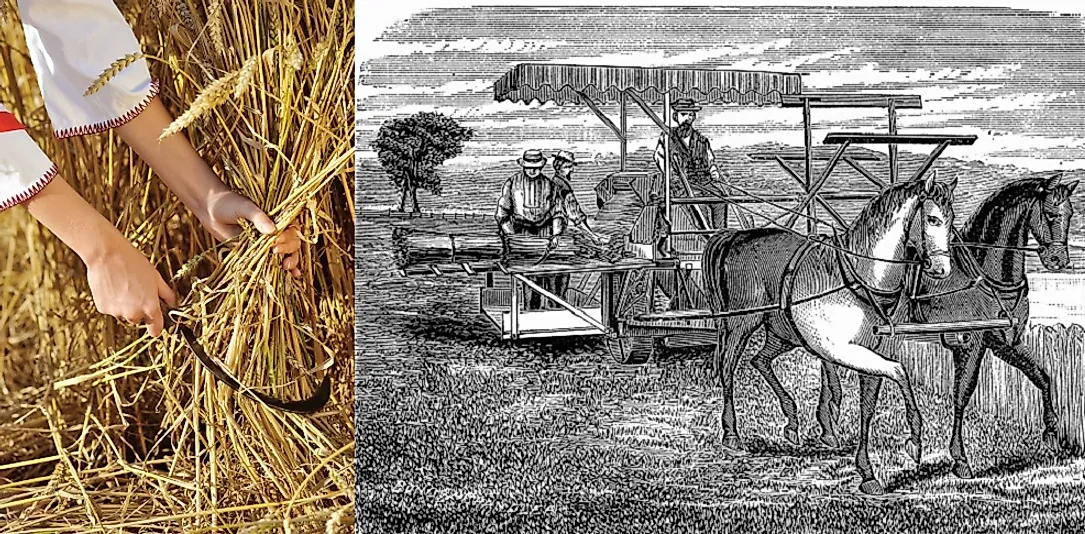Did The British Agricultural Revolution Lead To The Industrial Revolution?

The British Agricultural Revolution refers to the period of change from the traditional to modern farming systems in Britain that occurred between the mid-1600s and the late 1800s. Before the revolution, the open-field system of cultivation was used which caused cattle overgrazing, uncontrolled breeding, and spread of animal diseases. Mechanization and scientific principles were adopted, which led to increased productivity and efficiency. As agricultural outputs became increasingly more efficient, fewer workers were required, more food was on hand, and industries cropped up as a result of the agricultural revolution.
Factors Fueling the Agricultural Revolution
Several factors facilitated the revolution, the first being acts of Parliamentary legislation regarding land enclosure. A series of Parliamentary legislation in the United Kingdom promoted land consolidation, either owned or rented. The aim of this system was to establish separate chunks of land to allow efficient and economical utilization of land. The acts laid the foundation for a land-owning system in Britain. Large tracts of land could be utilized for agricultural purposes, and productivity increased. The formation of agricultural societies and annual shows facilitated innovation and the spread of ideas. More efficient methods were adopted as knowledge became widespread. Other factors were changing climatic conditions, increased populations of livestock, innovations and higher yields.
Changes in Technology and Farming Methods
Numerous changes characterized the revolution as machines replaced people in the farms. Notable innovations included the seed drill, which was invented by Jethro Tull and enabled seeds to be planted deep into the soil mechanically. Previously, seeds had been planted on the top layer and were quickly washed away or lost. The steam engine, improved and patented by James Watt, popularized the use of steam power and facilitated the invention of the steamboat by Robert Fulton. The Steamboat enabled faster and cheaper transport and facilitated the invention of the steam-powered train by Stephenson. With better infrastructure, produce could now travel throughout the country, a situation which further helped to boost trade.
Larger areas of land were further reclaimed through the draining of wetlands, the clearing of woodlands, and the transforming of upland pastures. The crop rotation system, championed by agriculturalists such as Charles Townshend, was widely adopted by farmers. In the system, fodder crops such as turnips and clover were planted instead of leaving the land fallow. Clover and Turnips were fed to cattle and also improved the soil fertility. Scientific animal breeding led to the development of the Shorthorn cattle, suited for both dairy and beef production. The Dishley Longhorn set precedence for more high quality and large-sized cattle to be developed. Robert Bakewell championed the selective breeding for sheep to develop larger breed with long and lustrous wool such as the Lincoln Longwool and New Leicester.
The threshing machine, invented by Andrew Meike, improved the efficiency of harvesting grain. Numerous other innovations included the Hay-tossing machine, the flying shuttle, the spinning jenny, and Crompton’s mule for the production of yarn. As more and more innovations were made, agriculture increasingly became automated.
Role of Climate and Weather Patterns
In the mid-1600s, the climate in England became colder and wetter, and intelligent seed selection became even more crucial for British farmers. New and superior varieties such as White-Eared Red Wheat, Red-Stalked Wheat and narrow-eared barley, which had an extended season and which could be stored in barns for lesser periods were developed. As more and more new crops were introduced, yields increased in return. Wetter climates also meant that rivers ran throughout the year and increased water supply.
Effects on Greater British Society and Trade
The effects of the revolution were immense and far-reaching. Now farmers were able to provide enough for the population, and the surplus produce was traded. Better infrastructure meant that produce reached local and international markets through exports. As food production increased, a rise in population was experienced as more people could be sustained. A large population in the UK became non-land holders as the tenure system of land came into effect, a situation which created a large market for agricultural produce and help boost trade. Improved trade enabled growth of the banking sector and development of loan facilities as economic assistance to farmers, and therefore underpinning industrial revolution.
The Agricultural Revolution's Facilitation of the Industrial Revolution
The agricultural revolution in Britain was instrumental in the developments that characterized the industrial revolution. The enclosure system had displaced people who subsequently moved into cities. A further increase in population provided labor for the industries. The agricultural revolution, which led to a greater abundance of food, had led to significant reductions in the prices of foodstuffs. The population thus had more disposable income to spend on industrial products. The need to sustain food production inspired more inventions in technology which facilitated the industrial revolution. During the agricultural period, the United Kingdom became economically prosperous and wealthy as farmers acquired capital to invest in industries and technology. The innovations in Agricultural revolution, coupled with improved infrastructure further fueled the industrial revolution.











